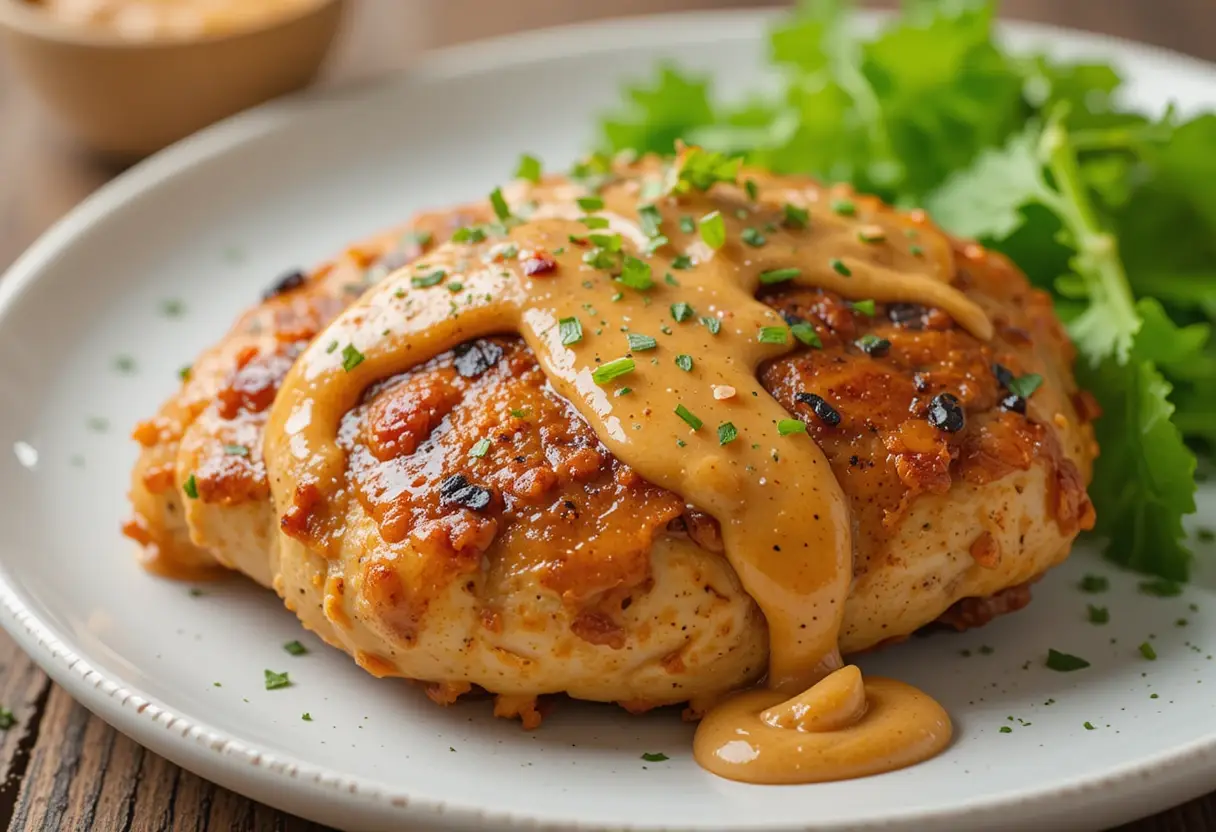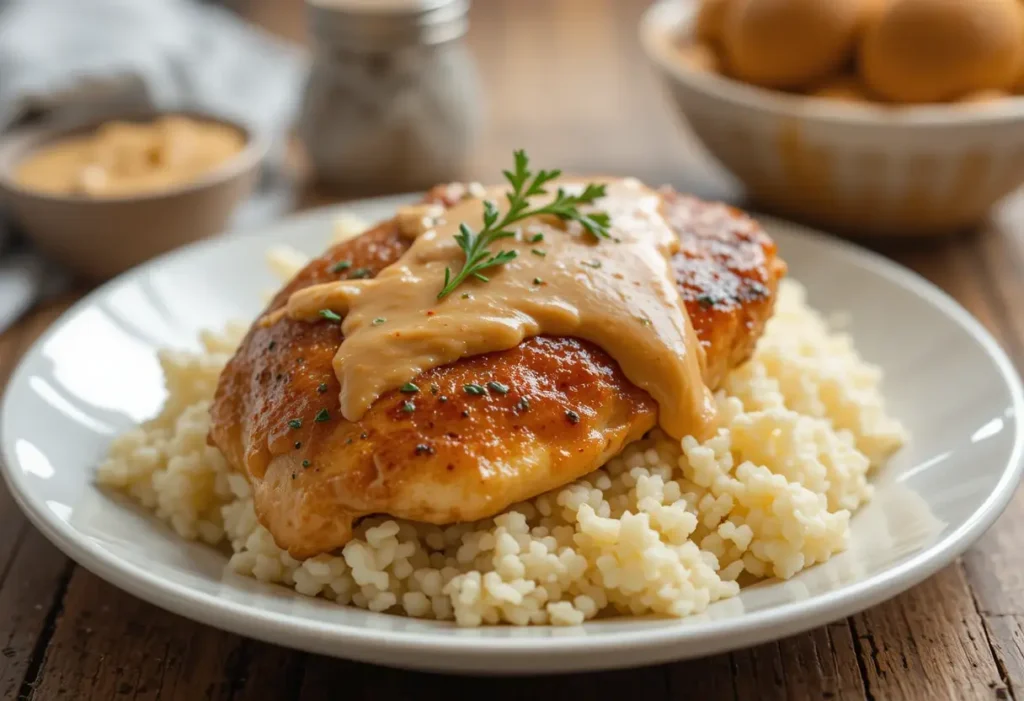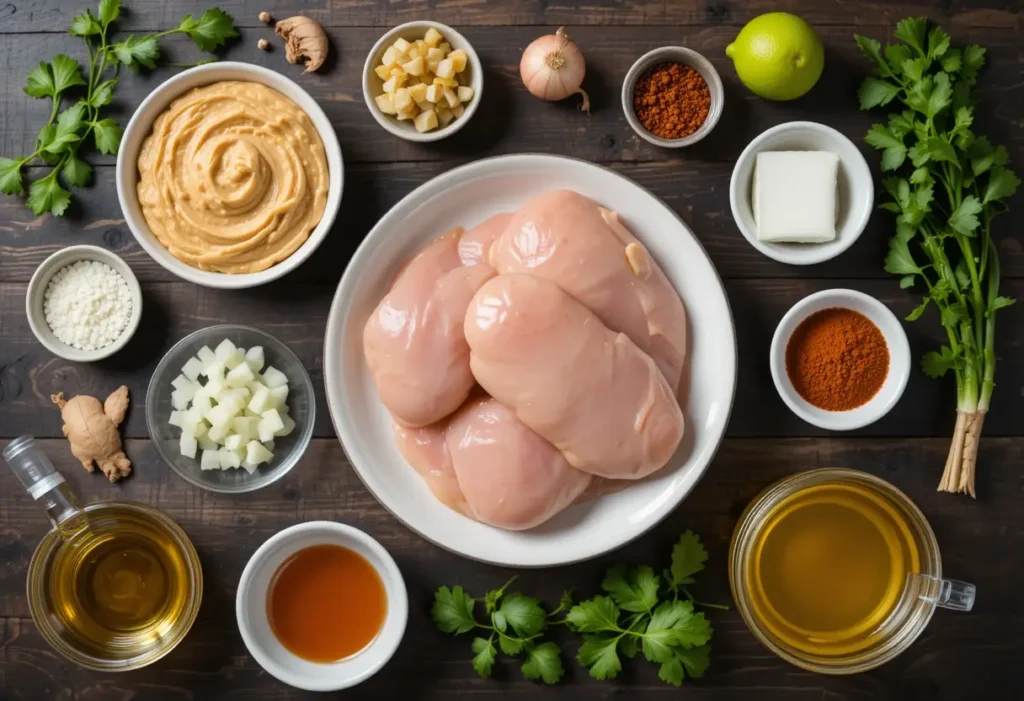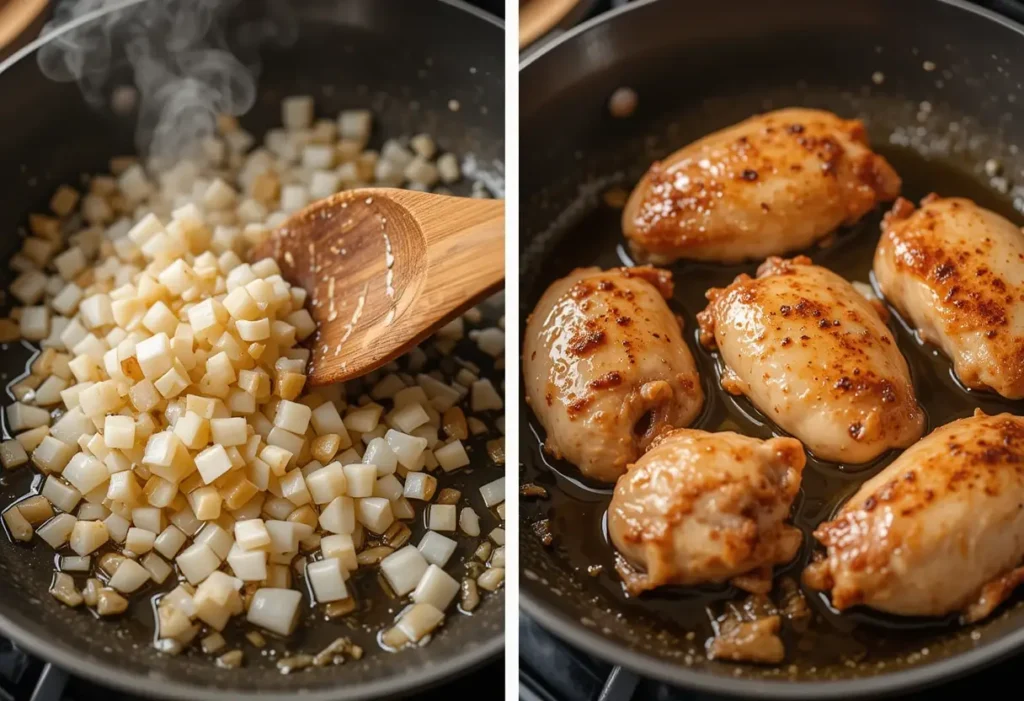Chicken with peanut butter is an exquisite fusion of savory and nutty flavors that creates a dish loved by food enthusiasts worldwide. This recipe is a delightful blend of tender chicken, creamy peanut butter, and a medley of aromatic spices, resulting in a meal that’s both comforting and versatile. Whether you’re looking to explore new culinary territories or impress guests with a unique dish, chicken with peanut butter is a must-try.
Table of Contents
What Makes This Dish Unique?
The uniqueness of chicken with peanut butter lies in its ability to harmonize contrasting flavors and textures. The richness of peanut butter creates a velvety sauce that envelops the chicken, while spices and seasonings enhance the overall taste profile. What truly sets this dish apart is its adaptability – it can be prepared as a hearty stew, a creamy curry, or even a tangy stir-fry. The combination of sweet, savory, and nutty flavors ensures a tantalizing experience for your taste buds.
Another remarkable feature is its nutritional value. Packed with protein from the chicken and healthy fats from peanut butter, this dish offers a satisfying and balanced meal. It can be paired with steamed rice, flatbreads, or even a fresh salad, making it suitable for various culinary preferences and occasions.
Origins and Cultural Significance
The origins of chicken with peanut butter trace back to several cuisines, particularly in West Africa and Southeast Asia, where peanuts are a staple ingredient. In West African cuisine, the dish is often known as “Groundnut Stew” or “Maafe,” highlighting its deep cultural roots. The inclusion of peanut butter in traditional recipes symbolizes resourcefulness and the ability to create hearty meals from locally available ingredients.
In Southeast Asia, peanut sauces are integral to dishes like satay, showcasing the region’s love for bold and aromatic flavors. Chicken with peanut butter reflects a fusion of these global influences, making it a testament to the culinary diversity that enriches our world.
This dish not only satisfies your appetite but also connects you to a rich history of culinary innovation and cultural exchange. Whether you enjoy it as a classic African stew or a modern adaptation, chicken with peanut butter offers a delicious journey through flavors and traditions.
Key Ingredients and Substitutions for Chicken with Peanut Butter recipe
Essential Ingredients for the Recipe
To prepare the delicious chicken with peanut butter recipe, you’ll need the following essential ingredients in measured quantities:
- Chicken: 1 pound (boneless, skinless chicken thighs or breasts, cubed)
- Peanut Butter: ½ cup (smooth or crunchy, depending on texture preference)
- Onion: 1 medium-sized (finely chopped)
- Garlic: 3 cloves (minced)
- Ginger: 1 teaspoon (grated)
- Tomato Paste: 2 tablespoons (for depth and richness)
- Coconut Milk: 1 cup (for creaminess)
- Chicken Broth: 1 cup (to balance consistency)
- Soy Sauce: 2 tablespoons (for umami flavor)
- Honey: 1 tablespoon (optional, for a touch of sweetness)
- Spices: 1 teaspoon paprika, 1 teaspoon cumin, ½ teaspoon cayenne pepper (adjust to taste)
- Oil: 2 tablespoons (vegetable or peanut oil for sautéing)
- Salt and Pepper: To taste
- Lime Juice: 1 tablespoon (for a fresh, tangy finish)
- Cilantro: 2 tablespoons (chopped, for garnish)
Substitutes for Allergy-Friendly Cooking
If you or your guests have dietary restrictions or allergies, here are some effective substitutions to make this dish allergy friendly:
- Peanut Butter: Swap with almond butter, sunflower seed butter, or tahini for a nut-free version.
- Coconut Milk: Use dairy free alternatives such as oat milk, cashew cream, or unsweetened almond milk.
- Soy Sauce: Replace with tamari for a gluten free option or coconut aminos for a soy free alternative.
- Chicken: Substitute with tofu, chickpeas, or jackfruit for a vegetarian or vegan adaptation.
- Oil: Use olive oil, avocado oil, or sesame oil based on availability or preference.
- Honey: Maple syrup or agave nectar work as vegan friendly sweeteners.
- Spices: For a milder dish, reduce or omit cayenne pepper; for a smoky kick, consider smoked paprika.
These substitutions ensure that the dish remains flavorful while accommodating different dietary needs. Adjusting ingredients doesn’t compromise the essence of the recipe, making it inclusive for everyone to enjoy!
Step-by-Step Cooking Guide
Preparing Your Ingredients
- Gather All Ingredients: Before starting, measure and prepare all ingredients to ensure a smooth cooking process.
- Chicken: Cube the chicken into bite sized pieces, ensuring uniformity for even cooking.
- Vegetables and Aromatics: Finely chop the onion, mince the garlic, and grate the ginger.
- Peanut Butter: If the peanut butter is thick, whisk it with a little warm water to create a pourable consistency.
- Spices: Measure out paprika, cumin, cayenne pepper, and salt to have them ready for seasoning.
Cooking Techniques for Perfect Results
- Sautéing Aromatics: Heat oil in a large skillet or saucepan over medium heat. Add the chopped onions and sauté until golden brown, then stir in the minced garlic and grated ginger. Cook for another minute until fragrant.
- Cooking the Chicken: Add the cubed chicken to the pan and cook until browned on all sides. This seals in the juices and enhances flavor.
- Building the Sauce: Stir in the tomato paste, peanut butter, spices, and soy sauce. Mix thoroughly to coat the chicken evenly.
- Simmering: Pour in the chicken broth and coconut milk, stirring to combine. Bring the mixture to a gentle simmer, then reduce the heat and let it cook for 15-20 minutes, allowing the flavors to meld.
- Adjusting Consistency: If the sauce is too thick, add a splash of chicken broth or coconut milk. If it’s too thin, simmer a little longer to reduce.
- Finishing Touches: Add lime juice for brightness and adjust seasoning with salt and pepper. Garnish with chopped cilantro for a burst of freshness.
Tips for a Creamier Peanut Butter Sauce
- Warm the Peanut Butter: Heat the peanut butter slightly before mixing it into the sauce to ensure smooth incorporation.
- Whisk Continuously: While adding the liquid ingredients, whisk constantly to prevent the peanut butter from clumping.
- Use Full Fat Coconut Milk: For a richer sauce, opt for full fat coconut milk rather than a lighter version.
- Blend for Extra Smoothness: If you prefer an ultra smooth sauce, use an immersion blender once the sauce has simmered to the desired consistency.
- Taste as You Go: Balance flavors by tasting frequently. Add a pinch of sugar or a drizzle of honey if the sauce tastes too savory or acidic.
By following these steps and tips, you’ll achieve a luscious, flavorful chicken with peanut butter dish that’s sure to impress!
Variations of the Recipe
Spicy Version for Heat Lovers
For those who crave bold, fiery flavors, try these additions to spice up your chicken with peanut butter dish:
- Cayenne Pepper: Double the amount in the recipe for extra heat.
- Fresh Chilies: Add finely chopped bird’s eye chilies, jalapeños, or serrano peppers during cooking.
- Hot Sauce: Stir in a tablespoon of your favorite hot sauce for a tangy, spicy kick.
- Chili Oil: Drizzle chili oil over the finished dish for an aromatic heat boost.
- Spicy Peanut Butter: Use a spicy peanut butter blend, or mix regular peanut butter with a pinch of chili flakes.
This variation pairs wonderfully with plain rice or cucumber salads to balance the spiciness.
Vegan Alternatives Using Plant-Based Ingredients
Transform this dish into a vegan friendly option while retaining its rich, nutty flavors:
- Chicken Substitute: Use tofu, tempeh, seitan, or chickpeas for a plant based protein.
- Broth Replacement: Swap chicken broth with vegetable broth for a flavorful base.
- Honey Alternatives: Use maple syrup, agave nectar, or omit for a less sweet profile.
- Coconut Milk: Ensure the coconut milk is dairy free (most brands are) and unsweetened.
- Add Vegetables: Include ingredients like sweet potatoes, zucchini, or spinach to enhance texture and nutrition.
This vegan variation is hearty, delicious, and perfect for plant based diets.
Common Mistakes and How to Avoid Them
Overcooking the Chicken
Overcooked chicken becomes dry and tough, detracting from the dish’s appeal. Here’s how to avoid it:
- Monitor Cooking Time: Chicken cubes cook quickly, typically in 7–10 minutes. Watch closely to prevent overcooking.
- Temperature Control: Use a meat thermometer to ensure the chicken’s internal temperature reaches 165°F (74°C).
- Simmering Instead of Boiling: Keep the sauce at a gentle simmer to cook the chicken evenly and prevent it from becoming chewy.
Balancing Flavors
Achieving a harmonious blend of flavors is crucial to the dish’s success. Avoid overpowering elements by:
- Taste Testing: Regularly taste the sauce as it cooks to adjust the seasoning gradually.
- Managing Sweetness: Use honey, sugar, or sweeteners sparingly. If the dish is too sweet, add a touch of lime juice or soy sauce.
- Controlling Salt: Salt should be added incrementally, especially if using salty ingredients like soy sauce or broth.
- Balancing Acidity: Lime juice is essential for freshness, but adding too much can overpower the dish. Incorporate it a little at a time.
By addressing these common pitfalls, you can create a perfectly balanced and flavorful chicken with peanut butter dish every time.
How to Store and Reheat
Best Practices for Storage
Proper storage is key to preserving the flavors and texture of your chicken with peanut butter dish. Follow these guidelines:
- Cooling Before Storage: Allow the dish to cool completely before storing to avoid condensation, which can dilute the sauce.
- Refrigeration:
- Place the dish in an airtight container to keep it fresh.
- Store in the refrigerator for up to 3–4 days.
- Freezing:
- Divide the dish into portion sized containers or freezer safe bags for convenience.
- Remove as much air as possible to prevent freezer burn.
- Label the container with the storage date for easy tracking.
- Freeze for up to 2 months for the best taste and texture.
- Separate Storage for Sides: If serving with rice, bread, or vegetables, store them separately to prevent sogginess or flavor absorption.
Tips for Reheating Without Losing Flavor
Reheat your chicken with peanut butter dish carefully to maintain its creamy consistency and vibrant flavors:
- Stovetop Reheating:
- Place the dish in a saucepan or skillet over low to medium heat.
- Add a splash of water, chicken broth, or coconut milk to loosen the sauce if it has thickened.
- Stir gently to distribute heat evenly and prevent sticking.
- Heat until just warmed through, avoiding overcooking the chicken.
- Microwave Reheating:
- Transfer a portion to a microwave safe container.
- Cover loosely with a lid or microwave safe wrap to retain moisture.
- Heat on medium power in 1 minute intervals, stirring between each interval for even reheating.
- Add a small amount of liquid if the sauce appears too thick.
- Prevent Overheating:
- Overheating can cause the sauce to separate or dry out the chicken. Heat only until the dish is warm.
- Enhance Freshness:
- Sprinkle fresh herbs like cilantro or add a squeeze of lime juice after reheating to revive the flavors.
- For spicy variations, top with chili oil or freshly chopped chilies.
By storing and reheating properly, you can enjoy the same creamy, flavorful dish even as leftovers!
FAQs About Chicken with Peanut Butter Recipe
Can I use a different nut butter?
Yes, you can use different types of nut butter as a substitute for peanut butter, depending on your taste preference or dietary needs. Some options include:
- Almond Butter: Offers a slightly sweeter and milder flavor.
- Cashew Butter: Provides a creamy and rich texture, similar to peanut butter.
- Sunflower Seed Butter: A great nut free alternative for those with allergies.
- Tahini (Sesame Seed Butter): Adds a nutty, earthy flavor that works well in savory dishes.
Ensure the nut butter you choose is unsweetened and smooth for the best consistency in the sauce.
Is this dish suitable for children?
Yes, this dish is suitable for children, especially if you adjust the spice levels to suit their palate. To make it more kid-friendly:
- Reduce Spices: Skip or lower the amount of cayenne pepper and other spicy ingredients.
- Add Sweetness: Incorporate a touch of honey or sugar for a slightly sweeter flavor that children may enjoy.
- Serve Creatively: Pair the dish with plain rice, noodles, or soft bread to make it more appealing to kids.
Always check for allergies to nuts or other ingredients before serving to children.
How can I make this dish gluten free?
This dish can easily be made gluten free with a few adjustments:
- Soy Sauce: Use gluten free soy sauce, tamari, or coconut aminos instead of regular soy sauce.
- Chicken Broth: Ensure the broth you use is certified gluten free.
- Additional Ingredients: Check all spice blends, tomato paste, and peanut butter for hidden gluten or cross-contamination.
- Side Pairings: Serve with gluten free sides such as plain rice, quinoa, or gluten free flatbreads.
By making these small changes, the recipe becomes safe and enjoyable for those with gluten sensitivities or celiac disease.
Conclusion
Chicken with peanut butter is a versatile, flavorful dish that reflects global culinary influences. For more exciting chicken recipes, explore the Mini Chicken Pot Pies for a hearty meal or learn how to create a vibrant Grilled Chicken Wrap for a quick, satisfying option. Expand your repertoire with these diverse recipes!




